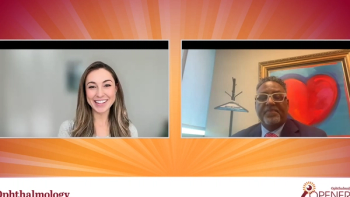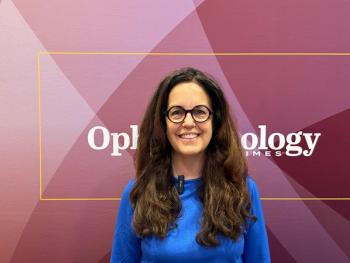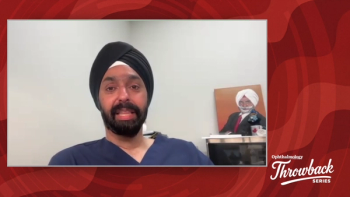
How new ‘evolving’ IOL formula maximizes lens accuracy
In the modern landscape of ophthalmology, there is an abundance of intraocular lens (IOL) calculation formulae. This often leads to a clinical dilemma when it comes to choosing the most appropriate formula.
By Aazim A. Siddiqui MD, Uday Devgan MD, and John G. Ladas MD, PhD, Special to Ophthalmology Times
In the modern landscape of ophthalmology, there is an abundance of intraocular lens (IOL) calculation formulae. This often leads to a clinical dilemma when it comes to choosing the most appropriate formula.
Figure 1A: Ladas Super Surface in its raw form
Thus far, there did not exist a perfect formula for all situations, including extremities of keratometry and axial length. Since there was no “one” formula, surgeons resorted to using multiple formulae without a framework to do so.
In developing the “Ladas Super Formula,” the first question we asked was: “How do we capture the best aspects of each formula, while minimizing their drawbacks?”
We looked at these formulae as the algebraic equations that they were. We wondered what we could do by simply graphing these formulae into three dimensions.
James Gleick, the author of Chaos: Making a New Science, said that “graphic images are the key” and “it’s masochism for a mathematician to do without pictures … [Otherwise] how can they see the relationship between that motion and this? How can they develop intuition?”
Figure 1B: A somewhat amalgamated Ladas Super Surface
Once we could visualize these formulae in 3-D, we decided to use this methodology to compare IOL formulae with each other, isolate them and join them together, and what we ended up with was the “Ladas Super Formula” (see Figure 1).
Figure 1C: Fully coalesced Ladas Super Surface
The Ladas Super Formula is a novel approach of taking the ideal portions of current IOL formulae and stitching them together to create one amalgamated surface and corresponding formula.
(All figures courtesy of Aazim A. Siddiqui, MD)
Real-life examples
The Ladas Super Formula automatically eliminates the surgeon’s need to mull over the various formulas or adjustments. It relies on peer-reviewed literature to incorporate the needed formulae and adjustments to reach the best-to-date results, and localizes to the correct region on the Ladas Super Surface for every individual patient. Any previously described formula and any future formula can be incorporated into the algorithm.
Figure 2A: The Ladas Super Formula Interface. An example with a short eye
Figure 2B: An example with a standard eye.
Figure 2C: An example with a somewhat long eye
Examples of the Ladas Super Formula in action are shown in Figures 2A, 2B, and 2C with a variety of eyes that a surgeon might come across on a daily basis.
Figure 2A shows the formula performing with a relatively short eye. The Ladas Super Formula recognizes that the patient has a short eye, and decides to choose the appropriate formulae and adjustments to yield the most accurate result.
Figure 2B is a similar example but showcases a more generic eye that resembles eyes many surgeons encounter in their operating rooms on a daily basis.
Figure 2C showcases a slightly longer eye. The Ladas Super Formula sees these eyes and decides to incorporate necessary adjustments the formulae need to calculate the most accurate result.
The Ladas Super Formula can be accessed free of charge at
Comparing formulae
With the Ladas-Siddiqui graph, surgeons have the ability to compare multiple formulae to determine where they resemble and differ from each other at entire ranges of corneal power and axial length. By doing so, surgeons can isolate regions of the formulae where a clinical dilemma may occur.
Surgeons, then, can target these areas as those that require the most discussion and improvement. With this graph, surgeons cannot only compare IOL power differences between formulae, but also various input parameters, such as anterior chamber depth (ACD).
Figure 3: The Ladas-Siddiqui graph. A graphical representation that highlights areas where the Ladas Super Formula and the SRK/T formula differ from each other by more than 0.5 D.
Such a task would have taken thousands of eyes to decide upon on a better formula for a given eye. An example of the Ladas-Siddiqui graph is shown in Figure 3, where the Ladas Super Formula is compared with the SRK/T formula.
Evolution of Ladas Super Formula
The key behind the Ladas Super Formula is its potential to limitlessly improve. The way surgeons go about improving any formula is to optimize it.
Thomas Olsen, the inventor of the Olsen Formula, has emphasized certain points regarding the optimization of a formula. He pointed out that optimization is formula-specific, and that other variables, such as ACD, can be used to “optimize” a formula-as shown in his paper on second eyes.1
The Ladas Super Formula in its current state represents the best of what already exists. However, to reach the end goal of truly accurate lens calculations, we are in the process of developing an evolutionary mechanism for the Ladas Super Formula so it continues to improve.
We are splitting the Ladas Super Surface into tiny “grid boxes,” which optimizes actual patient data. By making tiny adjustments to all aspects of the Ladas Super Surface in this manner, the current Ladas Super Formula will evolve and improve its accuracy.
We have developed an algorithm that incorporates and analyzes outcome data and adjusts the surface in all aspects. We have recruited multiple major cataract and refractive surgery groups to supply outcome data to aid the optimization process.
We track data from these groups, and use it to adjust and optimize the Ladas Super Surface accordingly. Figures 4A and 4B provide an idea of the progress made by highlighting the number of eyes we already have for optimization purposes within each grid box of the Ladas Super Surface.
This “real-world” data helps the Ladas Super Formula evolve and gives it a dynamic edge, which no previous formula had before, to further refine IOL calculations.
Figure 4A: The Manhattan Graph. A graphical representation of the optimization efforts so far where the Z-axis represents number of eyes that have been collected thanks to the participation of user groups.
Figure 4B: A bird's eye view of the Manhattan graph
Hypothetical user group
In Figures 4A and 4B, we have provided a distribution of the data already collected over the given ranges of corneal power and axial range from various user groups. We can see there exists a certain preponderance of eyes in a particular region of the surface.
As we cover every unit of the Ladas Super Surface, we will continue to optimize and perfect the Ladas Super Formula. The more eyes we are able to gather, the more refined the Ladas Super Formula gets. We are crowd-sourcing additional data so we can move up to a 100,000-plus eyes and then, eventually a 1 million or more eyes. Surgeons who wish to participate in this beta testing should contact the authors at the contact information at the end of this article.
Importance of ACD in IOL calculations
With this methodology of 3-D graphical representation, physicians can manipulate these formulae in many different ways. The issue of ACD is an important one when it comes to IOL calculations.
Parameters, such as axial length and corneal power, always have been related to the calculation of ACD calculation. By using these methods, we separate out the ACD from the modern IOL formulae, and figure out the similarities and differences in various ways ACD is calculated in these formulae.
This methodology is further applied not only to simple IOL calculations, but also to post-refractive IOL calculations and to accommodating IOLs.
For post-refractive IOL calculations, we essentially can split the ACD from the vergence calculation of the formulae. We then apply a double K method to treat the ACD and vergence calculation separately. It is generally believed that the ACD calculation is the most critical step in the calculation of IOL power, especially in small eyes with short axial lengths.
Conclusion
The Ladas Super Formula represents a novel step forward in the realm of IOL calculations. By leveraging 3-D mathematical modeling, we are able to understand modern IOL formulae like never before. By doing so, we also are able to take the best pieces of all formulae and amalgamate them together to create a single, ideal surface and consequently derive a formula (i.e., Ladas Super Formula).
The key functionality of the Ladas Super Formula concept lies in its innate dynamism, which leaves room for development of optimization techniques. It is a “living” formula that is constantly evolving, and becomes more accurate as it progresses. By collaborating with a number of user groups and incorporating their actual patient data, we can adjust every grid box of the Ladas Super Surface and further enhance its accuracy.
From this, we can obtain a Ladas Super Formula that will be more accurate than anything before it. The most appealing feature of this concept is that the Super Formula will never cease to improve.
Related:
Reference
1) Olsen T. Use of fellow eye data in the calculation of intraocular lens power for the second eye. Ophthalmology. 2011;118:1710-1715. doi: 10.1016/j.ophtha.2011.04.030. Epub 2011 Jul 2.
Aazim A. Siddiqui MD
P: 703/856-0801
John G. Ladas, MD, PhD
P: 301/928-1448
Uday Devgan MD
The authors have an ownership interest in the Ladas Super Formula and Ladas Super Surface and its associated methodologies and processes.
Newsletter
Don’t miss out—get Ophthalmology Times updates on the latest clinical advancements and expert interviews, straight to your inbox.



















































.png)


